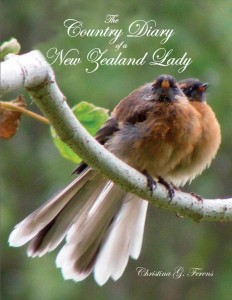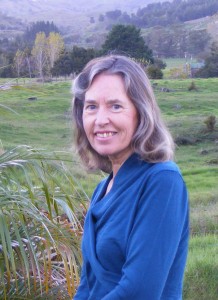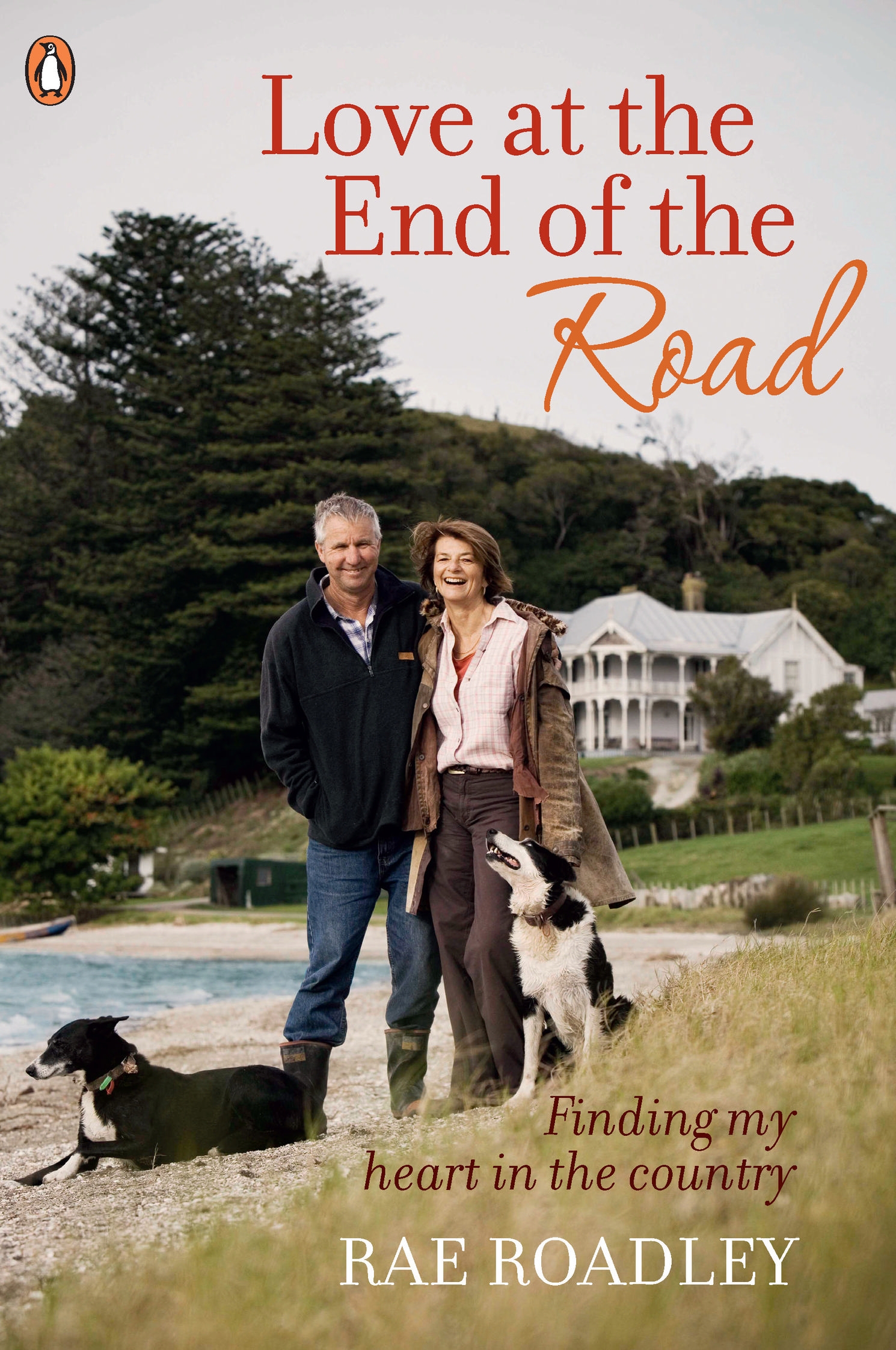 As a writer about rural life, I was recently asked to review a book by another Northland writer, Christina Ferens. The Country Diary of a New Zealand Lady is glorious; it’s both a meditation and a celebration of the birds, animals, and plants which many of us see every day and don’t give a second thought.
As a writer about rural life, I was recently asked to review a book by another Northland writer, Christina Ferens. The Country Diary of a New Zealand Lady is glorious; it’s both a meditation and a celebration of the birds, animals, and plants which many of us see every day and don’t give a second thought.
Her writing is excellent and inventive – she expresses her observations with clever originality. Her writing is also gentle, insightful, loving and reminiscent of a past era when people lived at a slower pace than most of us do today.
After the book launch at the Takapuna Library, Christina emailed to say she was pleased with my review (of course she was, it’s a fabulous book) and that she’d even referred to it during the launch. I asked Christina if she’d share some background about her book and life and she agreed.
Hi Christina – thanks for agreeing to be part of my blog.
My first burning question is this: your book includes many fabulous photos. What sort of camera do you use? Is it so tiny you can carry it with you almost constantly or do you set off on photographic missions, set yourself up and wait for the magic moment – or is it somewhere in between?
Not a pocket camera, but with the view-finder essential for bird photography and an extraordinary zoom capacity, the Fuji Finepix is light enough to be almost constantly round my neck. To capture those spontaneous moments, I soon learned to have it switched on and zoomed up before even setting foot outdoors and to leave it on till I was literally back inside, regardless of the drain on the battery. That way I caught the lovely pair of greenfinches so close when I was on my way indoors, finished for the afternoon as I thought.
Your writing is poetic and engaging. Do you scribble your thoughts in a notebook or do the words come to you when you sit at your computer? Or do you take a laptop into a paddock?
Thank you for the compliment. Nothing so organised as a notebook or even laptop!
I like to mull the words around in my mind when they come to me and to have pen and paper on hand wherever I am. By the end of the year I had a whole hand-written manuscript.
Is there a particular time of day when you write?
For the purposes of the diary, I would already be gathering up my thoughts by mid-morning and by late afternoon I was usually ready to wrap up my entry for the day. If I write a poem, I can be sure to see it during the ‘night watch’, the lines written clearly against the darkness so that I can make improvements which elude me in light of day.
I am quite used to writing in the dark!
What led to the publication of the book? Had you written a diary for some time and realised your scribing could grow into a book – or what? Was it your idea or someone else’s?
Certainly my own idea and one which had been germinating since I came across an old copy of “The Country Diary of an Edwardian Lady”. I imagined doing something beautiful like this for New Zealand and shortly afterwards, very late in the year, happened to move house to the perfect setting. On New Year’s Day I got out pen and paper.
A daily diary is a huge commitment. How did you manage to keep it up?
The enormity of what I had undertaken (the relentlessness, even, of the constant observations) came home to me one afternoon in March. By next morning I was as determined as ever and come the frostiest morning I was outdoors first thing in dressing-gown, gumboots and parka! I was having a love affair with words as well as with my subject, and I was spurred on by the knowledge that I was creating a unique record. Then, I had the advantage of hemisphere; with spring falling two-thirds through the year, followed by summer nesting, my involvement continued to grow and I was provided with a natural climax to the book.
Did you happen to count the number of species in the natural bird sanctuary around you?
There are 48 species of bird detailed in the appendix, and some gained the limelight more than others. I gave myself a rule that any mention at all was to shed an additional light or describe a new aspect of behaviour. By the end of the book, the reader should have built up a comprehensive knowledge of the birdlife.
What makes this book different from any other ‘bird book’ I’ve read is the fact that the birds seem to take on their own personalities. Can you comment on this?
There is certainly an intimate perspective to this natural history. A fascination for me, in observing the same bird families over the period of a year, is that different idiosyncracies did emerge, highlighting loyalty and personality beyond our own. The swallow couple, who nested opposite our front door, is a case in point.
Do you have an entry in your diary – and book – which is a particular favourite and which perhaps evokes fond memories?
Probably the last one, when I seemed led to the right spot at the right time throughout a day of memorable happenings that enabled me to draw in many of my main ‘characters’ and so ‘tie up all the ends’ in a satisfying way.
You must have been delighted to have your book as one of the best animal books of the year in the NZ Herald Canvas magazine. Has it been reviewed elsewhere?
The first review (copied below) ran in ‘”Bay Chronicle'”and ‘”Northern News'” and your own review for ‘”The Northern Advocate'” also ran in seven other provincial newspapers from ‘”Northern Age” to ‘”Oamaru Mail”.
Your book is published by Faith House Publications. Can you tell us a little more about them?
Being a books editor, I have set up my own publishing house by this name to produce my books, wall calendars and floral cards.
Is there a website where people can buy the book?
www.whitcoulls.co.nz If Whitcoulls are out of stock, purchase thru: [email protected]
What other writing have you done or had published?
“Where the Wind Wills” is a smaller book in which I first took natural history as a subject for literature. This time it is a whale at the ‘front door’, in the first of a series of seven unique and stunning environments from Island to Deep Country, from Ocean Beach to The Farm. This book includes my own pencil sketches rather than photographs, and also the original poetry. My first published poem appeared in “New Zealand Bookworld” many years ago.
If you had a word of advice for a writer, what would it be?
My advice is to visualise clearly the concept of the book and even, if designing it yourself, create the whole book in your mind’s eye from the outset, and then to write a list of goals and guidelines that will bring it into being.
Can you tell us a little about your farm – its size, how long it’s been in your family, etc?
Actually we rented the one dwelling on a farm being used as a run-off and bounding a vast sheep-and-cattle station. The farm is about 175 hectares and the beauty of it (apart from its very special plantings, such as a gingko tree by an unfrequented stream-crossing) is the extent of the wetlands that attract the birds. I never lost my sense of wonder at it all, being city-bred, and I think the success of the book derives from this wonder. I am told the book has opened the eyes even of those who have lived in the country all their lives.
And lastly, you live in rural Northland, but I have an idea your place is more remote than ours. We’re about 20 minutes’ drive from the nearest town – how far away are you?
We are still only 20 minutes’ drive from the nearest town.
Thanks for taking the time to share, Rae.
I’m grateful, Rae, for the opportunity to look back on the steps I took to achieve my goal. The journey was the best part.
PS: And here’s my The Northern Advocate review.
Christina Ferens lives on farm in the Far North where she notices the nuances of nature and writes about them – every day.
She also takes photographs, sometimes going to great trouble to capture that magic moment in time when, say, a turkey chick sits on its mother’s back or a drinking yearling is reflected in a pond.
The result of her labours with pen and camera is a glorious book that’s both a meditation and a celebration of the birds, animals, and plants which many of us see every day and don’t give a second thought.
Her writing is excellent and inventive – she expresses her observations with clever originality. Her writing is also gentle, insightful, loving and reminiscent of a past era when people lived at a slower pace than most of us do today.
Christina has an encyclopaedic knowledge of New Zealand birds; her skills even include determining whether a female or male blackbird “gave voice”.
Written as a journal, with one chapter per month, the book is peppered with photographs, mostly of birds but also of livestock and the countryside she clearly loves. She describes it as the Taheke hinterland.
This is not a book to be read in a rush, in fact, it would be my preference to keep it on my desk or at my bedside and read her observations as a daily ritual.
It commences on New Year’s Day (these are her notes from 2008) and the first entry details the antics of a fantail, a shining cuckoo, and a pair of nesting swallows whose fledglings need no longer “fling themselves with parted beak half over the edge of the nest in a limp effort to keep cool, for the man-of-the-house has kindly placed a piece of wood on the clear roofing above to protect them from the unrelenting summer sun.”
That excerpt – paragraph three in this 250-page, large format book – gives a sense of the pace and tone of what is essentially a diary. Entries rarely exceed 150 words; some are shorter. The typeface and layout make for an effortless read.
It would make a gorgeous gift. Yes, I know, suggesting any book would make a gift can seem to be damning it with faint praise, but that is not my intention.
As I have written this, with the book open beside me, I have felt my blood pressure settling, my mind calming and my mood lightening.
The book is a treasure that would be loved by anyone, but I imagine it might bring special joy to anyone who is say, in a rest home, in hospital, incapacitated, or who is locked in a corporate life – leaving home and arriving home in the dark with the intervening hours spent in a multi-storey building whether in Auckland or Hong Kong.
Anyone who lives on farm will identify, as will those folk who have left the family farm and now reside in an urban area.
The blurb likens the book to The Country Diary of an Edwardian Lady, written by Edith Holden in the early 1900s, published in 1977 and a best-seller. The Country Diary of a New Zealand Lady deserves that same good fortune.
Rae Roadley
Feast for bird and garden lovers
For most of us, busy with other things, seasonal differences are what we notice in the nightly weather forecast, but with this book author Christina Ferens invites us in to observe a feast of change that happens while our attention is elsewhere.
A day-by-day record of life in and around farm hedgerows and gardens takes us through the seasons of mating, breeding, rearing and feeding that busies the lives of birds and insects; all of it observed in fascinating close-ups and illustrated in a profusion of full colour photographs.
It’s also a sharp reminder that life at this level is lived in a jungle. Wasps and birds predate on insects, birds predate on each other, feral cats and possums predate on most things while overhead the big raptors cruise, looking for anything they can lift off the ground.
Christina identifies particular nests at risk and records the small wins as mothers fight fiercely to protect their young or the sad posses when they fail to prevent their eggs or chicks being snatched.
The entry for the first day of January is almost lyrical. “A fantail flew closely above my head as I stood in the shadow of the banksia, at the entrance to the lawn, and a shining cuckoo whistled sevenfold welcome to a new year just hours old. All day the welcome swallows flit about the rafters of the pergola where one pair tends a nest atop a wooden support; excited cheeping comes from two nestlings whenever a parent bird flits by. Sometimes they flutter in one spot, hummingbird style, taking insects from little spiders’ webs.”
Every day of the year is described with the same attention to detail, with birds identified in an appendix and their status, whether protected, native, endemic or introduced.
Christina Ferens lives in the Taheke hinterland, in Northland. Her love for the area and its natural beauty shines through on every page.
Bob Molloy Bay Chronicle; Northern News
“The charm of the language lends it to being read aloud … The other thing I really loved … is that you can get the picture of the stillness of the days and the intense heat of a Northland summer … there is just this quietness of nature … and I think it is a clever writer who can depict that.”
— Helen Woodhouse, Takapuna Library Manager, speaking at the book launch





Zana
December 18, 2012 at 8:45 am (UTC 13) Link to this comment
What a lovely interview. I’m so impressed, Christina, by your commitment to see this wonderful project through. Impressed too that you have your own publishing company.
Rae Roadley
December 18, 2012 at 9:24 am (UTC 13) Link to this comment
Thanks. Yes, creating a beautiful book – and forming a publishing company – is quite something.
Lynley
December 17, 2012 at 11:08 am (UTC 13) Link to this comment
Oh dear, Christina, not Christine, my apologies.
Lynley
December 17, 2012 at 11:07 am (UTC 13) Link to this comment
I am about to email Christine and buy myself a Christmas present. The book sounds glorious. I really like that you interviewed Christine and included that in your blog. The “back story” offers even more to the reviews contained here.
Can I reblog this post on my blog please Rae?
Rae Roadley
December 17, 2012 at 11:31 am (UTC 13) Link to this comment
You are most welcome – and Christina has visited the blog and is happy. Yes, her back story is great – love that she writes in the dark!
Lynley
December 17, 2012 at 11:38 am (UTC 13) Link to this comment
Thank you. Writing in the dark is quite something as you say Rae:-)
kiwiskan
December 17, 2012 at 10:52 am (UTC 13) Link to this comment
Thanks so much for this article Rae. It has given me a lot more insight into a lovely book – and an even bigger desire to buy it!
Rae Roadley
December 17, 2012 at 11:31 am (UTC 13) Link to this comment
Pleased to hear it. I loved learning about her writing process.